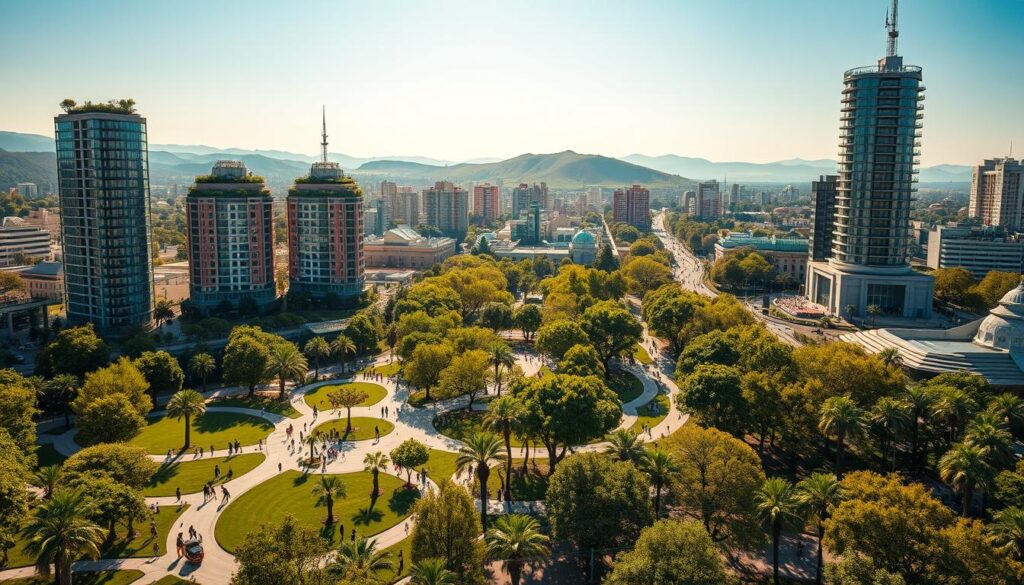As the world grapples with the challenges of climate change and rapid urbanization, the need for sustainable development has become more pressing than ever.
Can innovative green infrastructure engineering practices hold the key to a more sustainable future? By integrating natural systems with modern engineering processes, we can create sustainable water management systems and promote eco-friendly urban planning.
The development of sustainable infrastructure is crucial, as highlighted by initiatives tackling the four grand challenges in engineering the future.
Key Takeaways
- Innovative green infrastructure engineering is crucial for sustainable development.
- Sustainable water management is key to addressing climate change.
- Eco-friendly urban planning enhances the livability of urban areas.
- Integration of natural systems with modern engineering processes is vital.
- Sustainable infrastructure development is essential for the future.
Understanding Green Infrastructure Engineering
Green infrastructure engineering represents a significant shift towards sustainable urban planning, incorporating natural processes to mitigate environmental impacts. This approach to urban development focuses on creating livable, sustainable environments by integrating green spaces, renewable energy systems, and sustainable water management techniques.
Definition and Key Concepts
Green infrastructure is environmentally responsible planning and construction that harnesses natural processes to achieve sustainable development. Key components include green roofs, permeable pavements, and rain gardens, which work together to reduce urban pollution, manage stormwater runoff, and improve air quality.
By incorporating renewable energy systems like solar panels and hydrogen energy resources, cities can reduce their reliance on fossil fuels, lowering greenhouse gas emissions and contributing to a cleaner environment.
Importance in Urban Planning
The importance of green infrastructure in urban planning cannot be overstated. As cities continue to grow, the need for sustainable development strategies becomes increasingly critical. Green infrastructure helps to create resilient cities by managing environmental challenges, improving public health, and enhancing the quality of life for urban residents.
For more insights on the latest trends in green infrastructure, visit World Civil Society to explore innovative approaches to sustainable urban development.
Benefits of Green Infrastructure
By incorporating green infrastructure, cities can experience significant improvements in sustainability and quality of life. Green infrastructure, including elements like green roofs, permeable pavements, and rain gardens, plays a crucial role in enhancing urban environments.
Environmental Advantages
One of the biggest advantages of green infrastructure is its ability to preserve and enhance green ecosystems. With the recent initiative of incorporating green spaces, rainwater harvesting, and energy-efficient designs, cities can minimize pollution and improve air quality index. Green infrastructure helps in effective stormwater management by reducing runoff and filtering out pollutants, thus improving water quality.

Economic Benefits
Green infrastructure also offers significant economic benefits. By reducing the burden on urban drainage systems, it helps in lowering maintenance costs. Moreover, green infrastructure can increase property values and attract businesses, thereby boosting local economies.
| Economic Benefits | Description | Impact |
|---|---|---|
| Reduced Maintenance Costs | Lower costs for maintaining urban drainage systems | Significant savings for municipalities |
| Increased Property Values | Enhanced aesthetic appeal of neighborhoods | Higher property values and tax revenues |
| Business Attraction | Improved quality of life and environmental conditions | Attracts businesses and talent |
Social Impacts
The social impacts of green infrastructure are equally significant. By creating green spaces, cities can enhance the quality of life for residents, providing areas for recreation and social interaction. This can lead to improved public health and a stronger sense of community.
- Enhanced recreational spaces
- Improved public health
- Stronger community bonds
In conclusion, the benefits of green infrastructure are multifaceted, encompassing environmental advantages, economic benefits, and social impacts. As cities continue to grow, incorporating green infrastructure will be crucial for creating sustainable, resilient, and livable urban environments.
Key Components of Green Infrastructure
The key to a sustainable urban future lies in the effective implementation of green infrastructure components. Green infrastructure engineering encompasses various eco-friendly solutions designed to mitigate the environmental impacts of urbanization. By integrating natural systems into urban planning, cities can reduce pollution, manage stormwater more effectively, and create healthier environments for their residents.
Green Roofs
Green roofs are a pivotal component of green infrastructure. They involve planting vegetation on rooftops, which can absorb carbon dioxide, filter pollutants, and regulate building temperatures. This not only contributes to a healthier urban environment but also reduces the energy consumption of buildings. For instance, a study on green roofs in Chicago found that they can reduce the urban heat island effect by up to 5 degrees Fahrenheit.
Permeable Pavements
Permeable pavements are another crucial element, allowing rainwater to percolate through the surface, thereby reducing stormwater runoff. This helps in recharging groundwater and decreasing the burden on urban drainage systems. Permeable pavements can be made from various materials, including porous asphalt, permeable concrete, and interlocking pavers.
Rain Gardens
Rain gardens are shallow depressions planted with native vegetation that capture and filter rainwater. They play a significant role in managing stormwater at the source, reducing the risk of urban flooding, and improving water quality. Rain gardens also provide habitats for local wildlife, enhancing urban biodiversity.
| Component | Stormwater Management | Air Quality Improvement | Biodiversity Enhancement |
|---|---|---|---|
| Green Roofs | Moderate | High | Moderate |
| Permeable Pavements | High | Low | Low |
| Rain Gardens | High | Moderate | High |
In conclusion, the key components of green infrastructure work together to create more sustainable, resilient, and livable urban environments. By understanding and implementing these components effectively, cities can make significant strides towards achieving their sustainability goals.
Planning and Designing Green Infrastructure
Planning and designing green infrastructure involves a comprehensive approach to site assessment and community engagement. This ensures that the infrastructure is tailored to the specific needs of the local community and site conditions, ultimately contributing to sustainable urban development.
Site Assessment Strategies
Effective site assessment is the foundation of successful green infrastructure development. It involves evaluating the site’s environmental conditions, including soil quality, drainage patterns, and existing ecosystems. By understanding these factors, developers can design green infrastructure that complements the site’s natural characteristics. For instance, incorporating sustainable building materials can enhance the environmental benefits of green infrastructure.
| Assessment Criteria | Description | Benefits |
|---|---|---|
| Soil Quality | Evaluation of soil composition and health | Informs plant selection and drainage design |
| Drainage Patterns | Analysis of water flow and accumulation | Helps design effective stormwater management systems |
| Ecosystem Services | Assessment of existing biodiversity and ecosystem functions | Guides conservation and restoration efforts |
Community Involvement
Community involvement is crucial in the planning and design of green infrastructure. It ensures that the projects meet the needs and expectations of the local community, fostering a sense of ownership and stewardship. Effective community engagement can be achieved through public workshops, surveys, and collaborative design processes. By engaging with the community, developers can identify priorities and preferences, ultimately creating green infrastructure that is both functional and appreciated by the community.
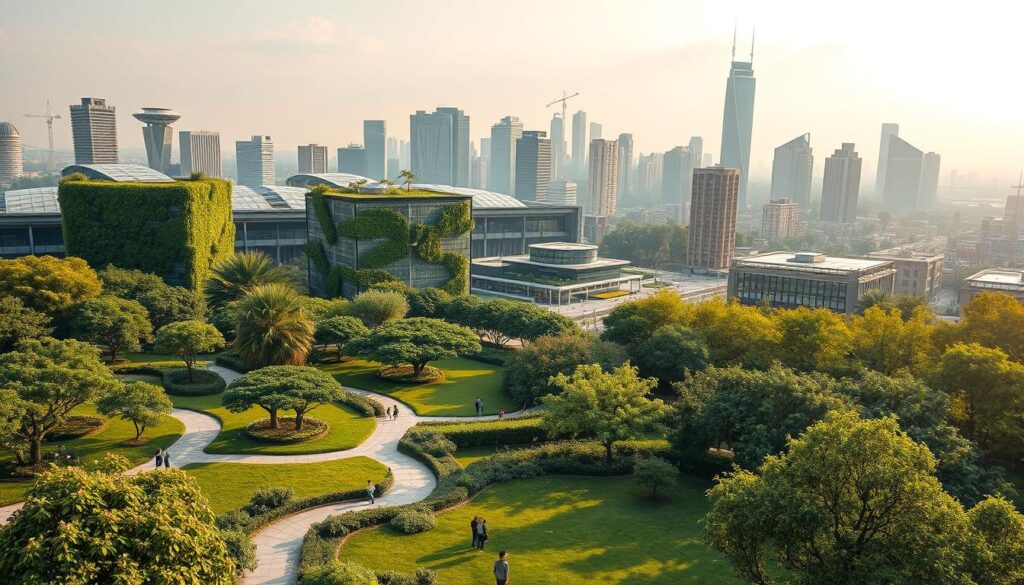
By integrating site assessment strategies with community involvement, green infrastructure projects can achieve greater success and sustainability. This holistic approach not only enhances environmental benefits but also promotes community well-being and resilience.
Innovations in Green Infrastructure Engineering
Sustainable urban development is being revolutionized by green infrastructure innovations. As cities continue to grow, the need for sustainable solutions to manage urban challenges becomes increasingly pressing. Green infrastructure engineering is at the forefront of this revolution, incorporating cutting-edge technologies and practices to create more resilient and sustainable urban environments.
Smart Technologies
The integration of smart technologies is transforming green infrastructure engineering. AI-powered energy management systems are optimizing energy consumption in urban areas, while automated irrigation systems are ensuring that green spaces are maintained efficiently. Furthermore, IoT-enabled waste management systems are streamlining waste collection, reducing costs, and improving the overall cleanliness of cities.
These smart technologies are not only enhancing the sustainability of green infrastructure but also making it more cost-effective. By leveraging data analytics and real-time monitoring, cities can better manage their resources and infrastructure, leading to more efficient and responsive urban planning. For more information on the latest research in this area, visit recent studies on green infrastructure.
Use of Native Plants
Another significant innovation in green infrastructure engineering is the use of native plants. Native plants are well-adapted to local climates and soil conditions, requiring less maintenance and resources. They also play a crucial role in supporting local biodiversity, enhancing ecosystem services, and improving the aesthetic appeal of urban green spaces.
By incorporating native plants into green infrastructure projects, cities can create more resilient and sustainable urban ecosystems. This approach not only reduces the environmental impact of urban development but also fosters a stronger connection between urban residents and their natural surroundings.
In conclusion, innovations in green infrastructure engineering, such as smart technologies and the use of native plants, are crucial for creating sustainable and resilient urban environments. As cities continue to evolve, embracing these innovations will be key to achieving a more sustainable future.
Case Studies of Successful Implementation
Green infrastructure engineering is transforming urban landscapes, as seen in several notable case studies. These examples highlight the effectiveness of eco-friendly urban planning and green building design in addressing environmental challenges.
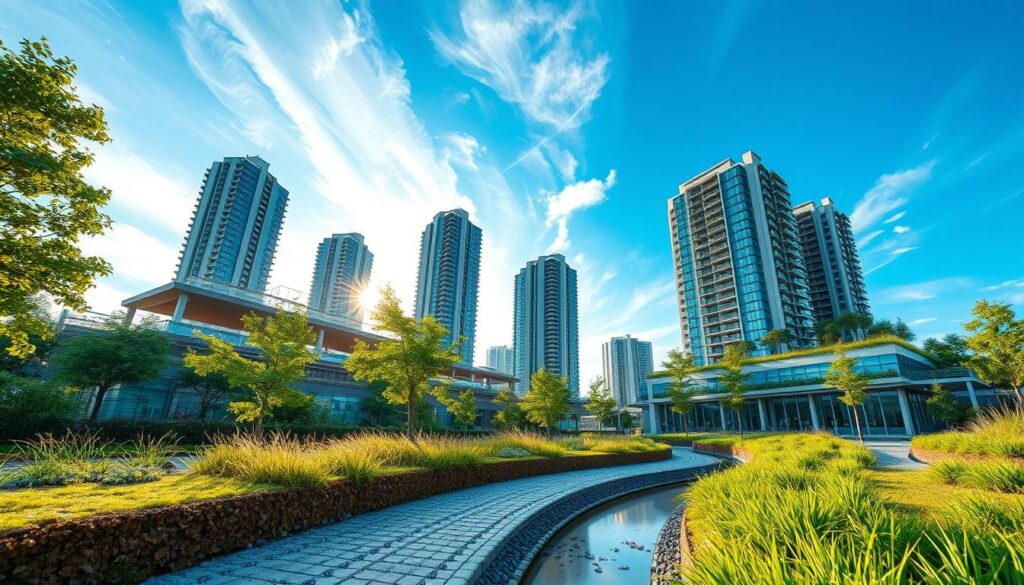
New York City’s Green Infrastructure Program
New York City has been at the forefront of implementing green infrastructure through policies that encourage green roofs and urban farming. These initiatives not only help reduce the city’s heat island effect but also improve air quality. As noted by city officials, “Green infrastructure is a critical component of our strategy to manage stormwater runoff and enhance the quality of life for our residents.” Successful green infrastructure projects like these serve as models for other cities.
The city’s green infrastructure program includes a range of strategies, from green roofs to permeable pavements. By adopting these innovative approaches, New York City aims to reduce its reliance on traditional gray infrastructure and create a more sustainable urban environment.
Philadelphia’s Stormwater Management Plan
Philadelphia’s Stormwater Management Plan is another exemplary model of successful green infrastructure implementation. The plan focuses on reducing stormwater runoff through the use of green infrastructure, such as rain gardens and green streets. This approach not only helps manage stormwater but also enhances the city’s aesthetic appeal and improves water quality.
“By investing in green infrastructure, we can create a more resilient and sustainable urban environment that benefits both our residents and our ecosystems.”
Philadelphia’s efforts demonstrate the potential for green infrastructure to play a crucial role in stormwater management. By integrating green infrastructure into their urban planning, cities can mitigate the impacts of urbanization and climate change.
In conclusion, the case studies of New York City and Philadelphia illustrate the significant benefits of green infrastructure engineering. By adopting eco-friendly urban planning strategies and green building design principles, cities can achieve substantial environmental, economic, and social benefits.
Challenges in Green Infrastructure Deployment
The adoption of green infrastructure is hindered by several key challenges that need to be addressed. Despite its numerous benefits, the implementation of green infrastructure faces obstacles that can slow its progress.
Funding and Resources
One of the primary challenges in deploying green infrastructure is securing sufficient funding and resources. The high initial costs associated with designing and installing green infrastructure can be a significant barrier, particularly for municipalities or organizations with limited budgets.
- Limited budget allocations for green infrastructure projects.
- Competing priorities for available funds.
- Lack of awareness about the long-term benefits of green infrastructure.
To overcome these challenges, it’s essential to explore innovative funding strategies and to educate stakeholders about the economic and environmental benefits of green infrastructure. This can include seeking grants, public-private partnerships, and other creative financing solutions.
Maintenance Issues
Another significant challenge is ensuring the long-term maintenance of green infrastructure. This includes regular upkeep, monitoring, and repairs to ensure that these systems continue to function as intended.
- Developing maintenance plans and schedules.
- Training personnel to manage and maintain green infrastructure.
- Securing ongoing funding for maintenance activities.
Effective maintenance is crucial for the success of green infrastructure projects. By prioritizing maintenance and adopting proactive strategies, cities can maximize the benefits of their green infrastructure investments.
Policy and Regulatory Framework
A well-structured policy and regulatory framework is crucial for the widespread adoption of green infrastructure. This framework not only guides the implementation of green infrastructure projects but also ensures their sustainability and effectiveness.
Local and Federal Regulations
Local and federal regulations play a pivotal role in shaping the green infrastructure landscape. Regulations can either hinder or facilitate the adoption of green infrastructure, depending on their design and implementation. For instance, zoning laws and building codes can be adapted to encourage the incorporation of green roofs and permeable pavements in urban planning.
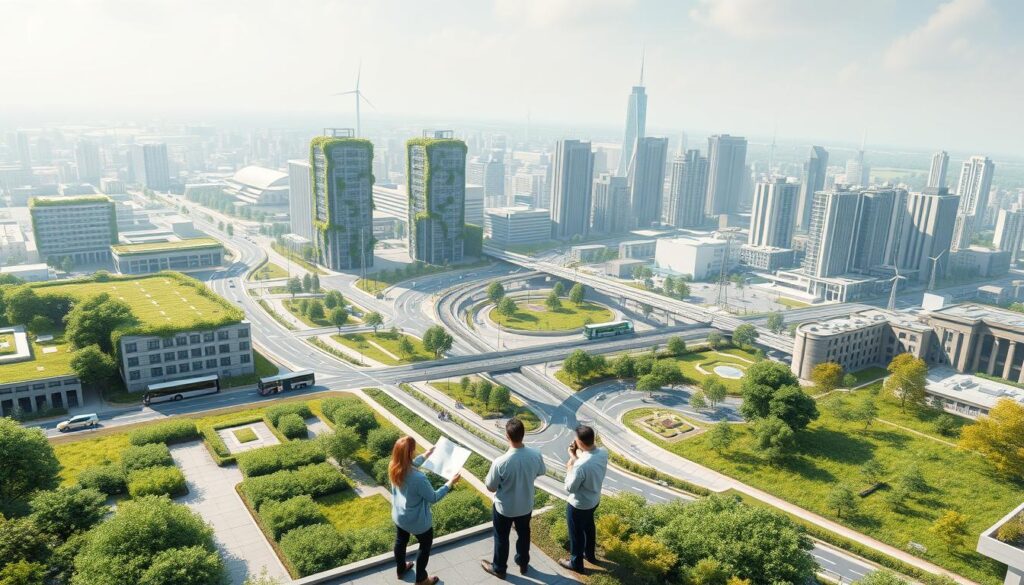
At the federal level, policies such as the Clean Water Act provide a foundation for water management practices that can be enhanced through green infrastructure. Locally, municipalities can implement stormwater management plans that include green infrastructure solutions, thereby reducing urban runoff and improving water quality.
Incentives for Green Infrastructure
Incentives are a powerful tool for encouraging the adoption of green infrastructure. These can come in various forms, including financial incentives, tax breaks, and density bonuses for developers who incorporate green infrastructure into their projects.
| Type of Incentive | Description | Example |
|---|---|---|
| Financial Incentives | Direct funding or grants for green infrastructure projects. | Stormwater management grants |
| Tax Breaks | Reductions in tax liability for properties with green infrastructure. | Property tax reductions for green buildings |
| Density Bonuses | Allowing for more development density in exchange for incorporating green infrastructure. | Increased floor area ratio for green roof installations |
By understanding and leveraging these incentives, cities can promote eco-friendly urban planning and sustainable water management practices, ultimately enhancing the resilience and livability of urban environments.
The Role of Engineers in Green Infrastructure
Engineers play a crucial role in shaping the future of green infrastructure through innovative designs and solutions. Their expertise is vital in developing sustainable urban environments that not only mitigate the effects of climate change but also enhance the quality of life for city dwellers.
Interdisciplinary Collaboration
The development of effective green infrastructure requires interdisciplinary collaboration. Engineers must work closely with urban planners, environmental scientists, and policymakers to design solutions that are both sustainable and feasible. This collaborative approach ensures that green infrastructure projects are well-integrated into the existing urban fabric and meet the needs of the community.
For instance, in designing green roofs, engineers need to consider not only the structural integrity of the building but also the selection of appropriate vegetation and the implementation of efficient irrigation systems. This requires a deep understanding of both environmental engineering solutions and green building design principles.
Continuing Education and Training
The field of green infrastructure is constantly evolving, with new technologies and practices being developed regularly. Therefore, it is essential for engineers to engage in continuing education and training to stay abreast of the latest advancements. This might include attending workshops on sustainable urban planning, participating in conferences on green infrastructure, or pursuing further education in specialized areas such as environmental engineering.
By committing to ongoing learning, engineers can ensure that their designs and solutions are at the forefront of green infrastructure development, contributing to a more sustainable future for urban environments.
Future Trends in Green Infrastructure
Green infrastructure is on the cusp of a revolution, driven by the need for climate resilience and sustainable practices. As urban areas continue to grow, the importance of integrating green infrastructure into city planning becomes increasingly evident.
Climate Resilience and Adaptation
Climate change is one of the most pressing issues of our time, and green infrastructure plays a critical role in enhancing climate resilience. By incorporating green roofs, permeable pavements, and rain gardens into urban design, cities can better manage stormwater runoff and reduce the risk of flooding.
Key strategies for climate resilience include:
- Implementing green infrastructure to manage stormwater
- Enhancing urban biodiversity through native plant species
- Promoting sustainable water management practices
As Dr. Jane Smith, a leading expert in urban planning, notes, “The integration of green infrastructure is not just about mitigating the effects of climate change; it’s about creating thriving, resilient communities.”
“The future of our cities depends on our ability to adapt to climate change through innovative green infrastructure solutions.”
Integrating with Transportation Networks
Integrating green infrastructure with transportation networks can significantly improve urban mobility while reducing emissions. This can be achieved through the creation of green corridors, the use of permeable materials for pavements, and the incorporation of green spaces along transportation routes.
| Benefits | Green Infrastructure | Traditional Infrastructure |
|---|---|---|
| Stormwater Management | Effective management through permeable pavements and rain gardens | Limited capacity, often leading to urban flooding |
| Air Quality | Improved air quality through green spaces | Minimal impact on air quality |
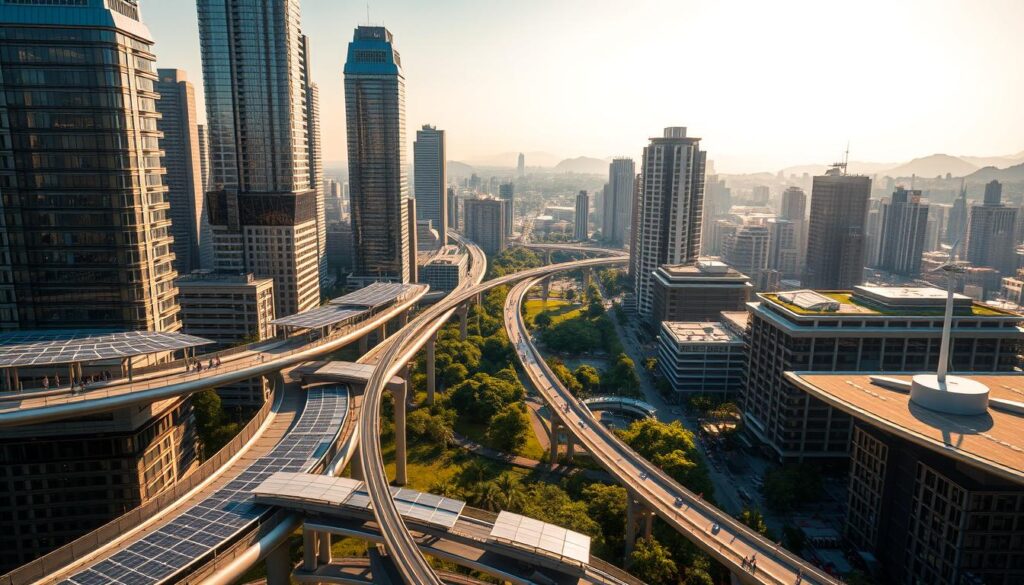
By embracing these future trends in green infrastructure, cities can move towards a more sustainable and resilient future, enhancing the quality of life for their inhabitants.
Community Engagement in Green Infrastructure Projects
Community engagement plays a vital role in shaping eco-friendly urban planning initiatives. By involving the community in green infrastructure development, cities can ensure that projects meet the needs and expectations of their residents.
Building Public Awareness
One of the key aspects of community engagement is building public awareness about the benefits and importance of green infrastructure. This can be achieved through various outreach and education programs. For instance, workshops, public meetings, and educational materials can help inform the community about the positive impacts of green infrastructure on their environment and quality of life.
According to the EPA’s guide on educating the community about green infrastructure, effective community engagement strategies include leveraging local media, organizing community events, and collaborating with local organizations.
Participatory Design Approaches
Participatory design approaches involve the community directly in the planning and design process of green infrastructure projects. This not only fosters a sense of ownership among community members but also ensures that the projects are tailored to their needs.
| Benefits of Participatory Design | Description |
|---|---|
| Increased Community Ownership | Community members feel invested in the project’s success. |
| Improved Project Design | Projects are tailored to meet the specific needs of the community. |
| Enhanced Public Acceptance | Projects are more likely to be accepted and supported by the community. |
By adopting participatory design approaches and building public awareness, cities can develop green infrastructure that is not only sustainable but also meets the needs of their communities.
Measuring the Impact of Green Infrastructure
Measuring the impact of green infrastructure requires a comprehensive approach that incorporates various metrics and evaluation techniques. This involves assessing the environmental, economic, and social benefits of such projects to understand their overall effectiveness.
Metrics and Evaluation Techniques
To evaluate the success of green infrastructure projects, it’s essential to use a range of metrics. These can include measures of stormwater management, such as the volume of water retained or the reduction in runoff. For instance, a study on measuring the effectiveness of green infrastructure highlighted the importance of monitoring stormwater retention. Other metrics might focus on the improvement in water quality, biodiversity, or community engagement.
Key evaluation techniques include:
- Monitoring water quality parameters such as pH, turbidity, and nutrient levels
- Assessing the reduction in urban heat island effects through temperature monitoring
- Evaluating the impact on local biodiversity by conducting species surveys
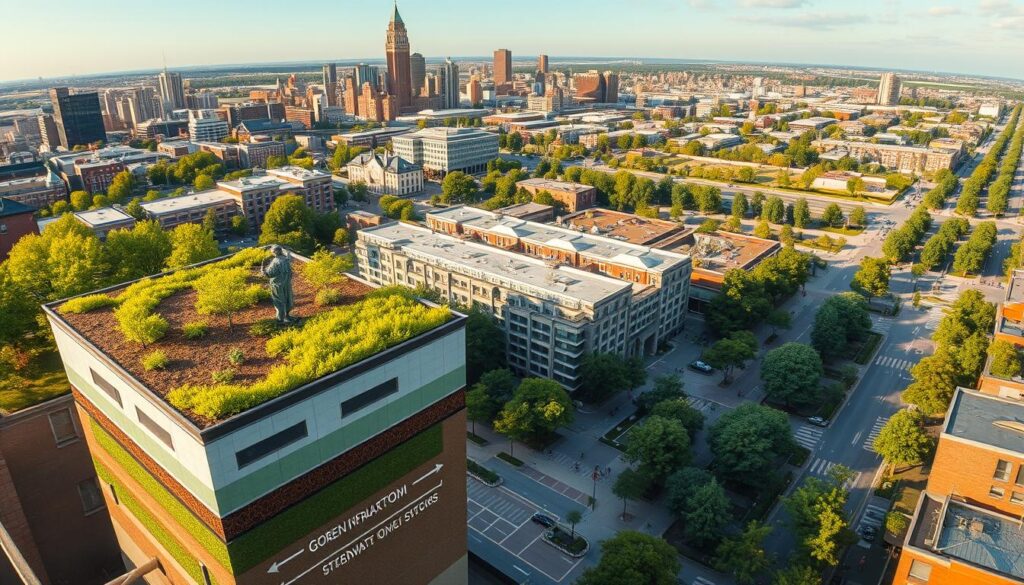
Long-term Monitoring
Long-term monitoring is crucial for understanding the sustained impact of green infrastructure. This involves tracking the performance of projects over time to identify any changes or trends. Continuous monitoring allows for the early detection of issues and the implementation of corrective measures, ensuring that the infrastructure remains effective.
Some key aspects of long-term monitoring include:
- Regular inspections of infrastructure components
- Continuous data collection on water quality, flow rates, and other relevant parameters
- Community feedback mechanisms to understand the perceived benefits and challenges
By adopting a rigorous and multi-faceted approach to measuring the impact of green infrastructure, cities can ensure that their sustainable water management strategies are effective and resilient. This, in turn, contributes to the development of environmental engineering solutions that support a healthier and more sustainable urban environment.
The Role of Technology in Green Infrastructure
Technology plays a pivotal role in advancing green infrastructure development, enabling cities to become more sustainable and resilient. The integration of innovative technologies is transforming urban planning and the implementation of green infrastructure projects.
One of the key technologies driving this change is Geographic Information Systems (GIS). GIS allows for the detailed mapping and analysis of urban environments, helping planners identify the most suitable locations for green infrastructure projects. By analyzing spatial data, GIS facilitates low-impact development strategies that minimize environmental disruption.
Geographic Information Systems (GIS)
GIS technology is crucial for assessing the spatial relationships between different urban features and potential green infrastructure sites. It enables planners to visualize the impact of their decisions on the urban landscape and make informed choices about where to implement green infrastructure.
For instance, GIS can be used to identify areas with high stormwater runoff, allowing planners to design targeted green infrastructure solutions such as rain gardens or permeable pavements. This not only enhances the effectiveness of green infrastructure but also contributes to climate-resilient infrastructure by mitigating the effects of extreme weather events.
Data Analytics for Urban Planning
Data analytics is another vital tool in green infrastructure development. By analyzing data on urban conditions, planners can predict future challenges and design infrastructure that meets the needs of a growing population. Data analytics can help identify trends in environmental conditions, population growth, and infrastructure performance, enabling more effective urban planning.
For example, data analytics can be used to monitor the performance of existing green infrastructure projects, providing insights into what works and what doesn’t. This information can then be used to refine future projects, ensuring that they are more effective and sustainable. As discussed in more detail on the Living Architecture Monitor, the role of technology in designing green infrastructure is multifaceted and crucial for creating sustainable urban environments.
Funding Opportunities for Green Infrastructure
Green infrastructure engineering requires significant investment, making funding opportunities a vital aspect of sustainable water management. Various financial sources are available to support the development of eco-friendly urban planning initiatives.

Grants and Public Funding Sources
Numerous grants and public funding sources are available for green infrastructure projects. Government agencies, both at the local and federal levels, offer grants to support initiatives that enhance environmental sustainability. For instance, the Environmental Protection Agency (EPA) provides funding for projects that improve water quality and promote green infrastructure.
- EPA’s Green Infrastructure Program
- HUD’s Community Development Block Grants
- DOT’s Transportation Infrastructure Grants
These programs not only provide financial support but also encourage innovation in green infrastructure engineering.
Private Investment Strategies
In addition to public funding, private investment strategies play a crucial role in advancing green infrastructure. Public-Private Partnerships (PPPs) are increasingly being used to finance large-scale green infrastructure projects. Private investors are attracted to these projects due to their potential for long-term returns and positive environmental impact.
Private investment can come in various forms, including:
- Direct investment in green infrastructure projects
- Green bonds specifically issued for environmental projects
- Investments in companies specializing in green technology
By leveraging both public and private funding sources, communities can implement comprehensive green infrastructure plans that support eco-friendly urban planning and contribute to a sustainable future.
Green Infrastructure Myths Debunked
There’s a significant gap between the perceived and actual benefits of green infrastructure, largely due to prevailing myths. As the world shifts towards more sustainable practices, it’s crucial to address these misconceptions to foster a wider adoption of green infrastructure.
Misconceptions About Costs
One of the primary myths surrounding green infrastructure is that it’s prohibitively expensive. However, numerous studies have shown that while initial costs might be higher, the long-term benefits and savings significantly outweigh these upfront expenses.
- Long-term Savings: Green infrastructure can reduce stormwater management costs and decrease the burden on urban drainage systems.
- Economic Benefits: It can increase property values and contribute to local economic growth through job creation in green engineering and maintenance sectors.
Moreover, innovative financing models and government incentives are becoming more available, making it easier for cities and towns to invest in green infrastructure.
Performance Myths
Another common myth is that green infrastructure doesn’t perform as well as traditional infrastructure. However, evidence suggests that when properly designed and maintained, green infrastructure can be highly effective.
- Green roofs can significantly reduce urban heat island effects and improve air quality.
- Permeable pavements and rain gardens can effectively manage stormwater runoff, reducing the risk of urban flooding.
By understanding the facts behind green infrastructure, communities can make informed decisions that benefit both the environment and the local economy.
Conclusion: A Sustainable Future with Green Infrastructure
Green infrastructure engineering is a vital component in the quest for a sustainable future. By integrating green engineering solutions into urban planning, communities can effectively mitigate the impacts of climate change, improve public health, and stimulate economic growth through sustainable water management practices.
Empowering Communities
Communities must take an active role in adopting and promoting green infrastructure. This involves investing in climate-resilient infrastructure, supporting local initiatives, and fostering a culture of sustainability among residents.
Advancing Green Solutions
The future of green infrastructure depends on continued innovation and collaboration among engineers, policymakers, and the public. By working together, we can develop and implement effective green infrastructure solutions that enhance the quality of life for urban residents while protecting the environment.
